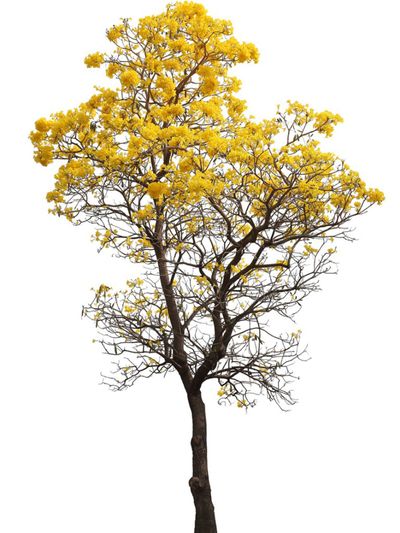What is a Tabebuia Tree?
There are over 100 types of trumpet trees in the genus Tabebuia. Some can get up to 160 feet (49 m.) tall, but most are smaller trees of only 25 feet (7.5 m.) or less. They may produce multiple trunks or form a single leader stem. The flowers are a spring spectacle with 1 to 4 inch (2.5 to 10 cm.) wide blooms that hang in clusters. The name the trumpet tree comes from these blooms, which are tubular and lightly frilled at the top with multiple stamens. Most varieties have golden flowers, which leads us to another name for the plant, tree of gold. Another feature of the plant are the seed pods, which may be anywhere from 3 to 12 inches (7.5 to 30.5 cm.) and dangle long into the cold season, providing winter interest. Tabebuia tree care is easy breezy and perfect in warmer zones in many locations and has no root problems.
Types of Trumpet Trees
The wide variety of flower colors boasted by this genus provides the gardener with several choices of the tree to provide color, scent and movement to the home landscape. The gold blooms are most common, but there are also the pink Tabebuia and the purple variety. A Silver trumpet tree has light gray bark, yet maintains the classic golden blooms. You will also find Tabebuia with white, magenta or red blooms, but these may be harder to find. Almost all varieties of the plant will have the silvery leaves which are characteristic of this lovely tree.
Growing Tabebuia Trees
While tolerant of a variety of soils, Tabebuia growing conditions must include a warm location with no freezing possibility. The plants have a high drought tolerance, but do prefer fertile soil with good drainage. If your garden has clay, loam, sand or any soil pH, these will still fulfill appropriate Tabebuia growing conditions. Tabebuia is adaptable to full to partial sun locations, and some will even tolerate a light freeze and come back in the milder zones. Pruning the dead wood and brittle old stems is an essential part of Tabebuia tree care. In Brazil and several other warm climates, growing Tabebuia trees as timber provides an important industry product. The plant is relatively disease and pest resistant, which is a trait that carries over to the timber. It makes a lovely deck that is durable and ignored by most of the timber insect species. This means it doesn’t need the chemical treatments that many deck woods require. Tabebuia trees are attractive and adjust to many growing conditions. Adding this tree to your landscape is worth the effort it will take to find the plant. The rewards are numerous and the care is minimal.
